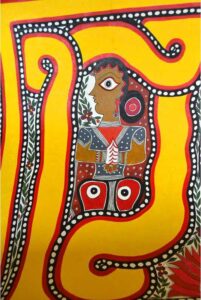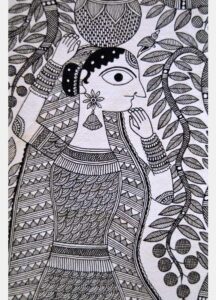Madhubani, also called Mithila painting, originated in the Mithila region in present day Bihar. While its distinctive style and vibrant colours have garnered global attention, there are several lesser-known facts about Madhubani!

Madhubani art, Bharni Style by Baua Devi of Jitwarpur (Bihar)
- Ancient Origins: Madhubani art can trace its roots back to ancient times. It is believed to have been practiced for over 2,500 years. The first documented reference to this art form can be found in the Ramayana. It is mentioned that King Janaka, the father of Sita, the heroine of the Ramayana, asked artists to decorate his kingdom with intricate paintings, laying the foundation for Madhubani art.
- Hidden Stories in Every Stroke: Madhubani art is not merely an aesthetic endeavour; it is a means of storytelling. Traditionally, women in the Mithila region used this art form to narrate myths, legends, and daily life through their paintings. Each element in a Madhubani painting, from the patterns to the colours, holds significance and tells a tale.
- Two Main Styles: While Madhubani art is known for its intricate designs and vibrant colours, there are two main styles within the tradition: the Bharni style and the Kachni style. The Bharni style, literally meaning, to fill, involves completely filling in the patterns with colours, while the Kachni style employs finer lines and more intricate detailing, often in black and white. There are other styles, Godhna, inspired by tattooing traditions, Tantrik, and Kohbar, which is usually meant for nuptial nights.
- Earthy Palette: Traditionally, Madhubani artists use natural pigments for their creations, even as this is fast changing. These pigments are sourced from locally available materials such as turmeric, indigo, pomegranate, and charcoal. The limited colour palette gives Madhubani art its distinct earthy and rustic charm.

Part of a Kachni style Madhubani painting by Mahalaxmi of Ranti (Bihar)
- Ritualistic Art: Madhubani art plays an integral role in various rituals and ceremonies in the Mithila region. It is often used to decorate homes during festivals, weddings, and other significant events. The paintings are believed to bring good luck and ward off evil spirits.
- Female Dominance: While there are male Madhubani artists, the art form is primarily dominated by women. Historically, women in Mithila would pass down this traditional art from one generation to the next. This matriarchal tradition has been crucial in preserving the art form’s authenticity.
- Eco-Friendly Canvas: Traditional Madhubani paintings are created on handwoven cloth or paper made from rice straw. This eco-friendly approach not only adds to the art form’s uniqueness but also aligns with the principles of sustainability.
- UNESCO Recognition: In 2016, Madhubani art was recognized as an “Intangible Cultural Heritage of Humanity” by UNESCO. This prestigious recognition has helped raise awareness about this traditional art form and its importance in preserving cultural heritage.
- Contemporary Evolution: While Madhubani art has deep-rooted traditional elements, it has also evolved over time. Many contemporary artists have taken inspiration from the traditional form and incorporated modern themes and materials, giving rise to a fusion of tradition and innovation. Take a look at Club Artizen’s products like the Paper Mache Pen Stand, inspired by Madhubani.
- Global Appeal: Madhubani art has transcended regional boundaries and gained international acclaim. It is now featured in exhibitions and collections worldwide. This global recognition has not only boosted the livelihoods of Madhubani artists but has also introduced this remarkable art form to a broader audience.
In a world increasingly driven by technology and modernity, Madhubani art stands as a testament to the rich cultural tapestry of India. Its longevity, intricate detailing, and storytelling prowess continue to captivate art enthusiasts and cultural aficionados around the world. As we uncover these little-known facts about Madhubani art, we gain a deeper appreciation for the craftsmanship and heritage it represents. This art form reminds us of the importance of preserving and celebrating our cultural roots, ensuring that they thrive for generations to come.
Our Madhubani products


